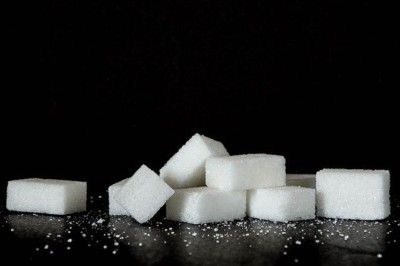Sugar – Blessing or curse?
40 Kg! This is the answer to the question of how much sugar each German actually devours on average per year.
Whether with the midday coffee, in the sweetened lemonade or also in the ready-made sauce with the snack op di Eck, daily nearly 110 g pure sugar or more simply formulated about 22 teaspoons of the white stuff are consumed.
Until a few centuries ago, industrial processed sugar was hardly known and played a minor role in the industry.
Today, it is impossible to imagine everyday life without sugar and it is strictly controlled and protected by the industry and lobbyists so that the sugar image remains as pure as its crystals are.
1. Attack of the sugar lobby!
Only ca. 28% of working Germans cook for themselves, and only on weekends, with a downward trend.
Even though organic food trends and the number of quality shoppers interested in unprocessed and high-quality foods are slowly increasing, convenience is still evident among the great masses.
The industry continues to promote this convenient triumph of „convenience food“ with large-scale marketing campaigns.
All of a sudden, nature is not good enough and faster, easier ways have to be found.
Nowadays sugar can be produced cheaply, is available everywhere and has never been used so much in foods.
Hardly any industry can do without the inexpensive filler, and so suspect product categories have developed over the past decades.
Thus, the market has been flooded with beverages such as z.B. Energy drinks literally flooded, which after a brief review of the core target group actually no raison d’être have.
These interesting customer groups must of course be kept happy, so that the manufacturers lack the incentive to change anything.
There are only a few companies like z.B the young Start up HAFERVOLL which against the trend, their products completely without sugar manufacture.
In general, the industry takes advantage of the enormous immaturity of consumers. While the Young Persons Protection Act specifically prohibits cigarettes from being sold to minors, these products may be sold to minors without a warning label.
Not only does this consumer group lack any idea of health-related consequences, they simply cannot evaluate the energy content or the sugar contained in a product.
To add to this general confusion, moreover, are the ingredient lists written hyroglyphically:
Ingredients:
Glucose fructose syrup, milk chocolate (sugar, cocoa butter, whole milk powder, cocoa mass, emulsifier: Soy lecithins), wheat-rice extrudate (wheat flour, rice flour, sugar, dextrose, wheat and barley malt flour, salt), invert sugar syrup, 10% rolled oats, wheat-chocolate extrudate (wheat flour, Sugar, highly de-oiled cocoa powder, wheat starch, barley malt), fructose, cornflakes (corn, sugar, salt, barley malt), vegetable oil, maltodextrin, cocoa mass, honey, emulsifier: Lecithins, salt.
In the example above, it is still easy to see the numerous uses of industrial sugar.
The fact that this product was originally intended as a muesli bar cannot be seen from the list of ingredients and is evidence that this product consists largely of pure industrial sugar.
The multiple use of different types of sugar is an attempt to reduce the quantity of a sugar used, so that it slips down the list of ingredients.
So rather use five different sugars slightly than one sugar in high doses.
The direct comparison of a young company shows that even with purely natural ingredients a tasty muesli bar can be realized.
Ingredients:
Oatmeal, sunflower oil, honey, hazelnuts, cocoa, cocoa bean pieces (available at www.oatmeal.de)
2. Modern snacks are full of the „natural“ poison!
Since as early as the 19th century. In the 21st century, the sugar industry is trying to support or even manipulate positive scientific research with a budget of millions of dollars.
To this day, billions are spent every year to revive the bad reputation of sugar.
And the tip of the brazen sugarberg is emerging in large-scale advertising campaigns that try to hide the fact that sugar is not just empty calories.
But this sugar lobbyism can not destroy the irrefutable fact that sugar contains no vitamins and is also low in nutrients.
For example, the amount of magnesium in 100 g of sugar is only 0.2 mg and is therefore hardly worth mentioning.
Brown sugar or organic whole cane sugar does not contain significantly higher amounts of vitamins or minerals compared to white sugar, and yet the industry likes to promote it as a higher-quality version.
Even many organic products try to suggest that organic sugar is a high-quality ingredient.
Here is the clear demand: Consumers should be much more clearly informed about the ingredients of sweet foods.
Where appropriate, even warning labels should draw attention to health risks.
Another ridiculous advertising slogan of the industry is the enormous purity of sugar.
With almost 100% yield the white gold can be extracted from the sugar beet, however, the industry conceals that a sugar beet is much more valuable as a complete food.
When eating a sugar beet, the body is supplied not only with carbohydrates but also with fiber, vitamins and minerals.
Then eat not only sugar, because the beet also contains fiber, vitamins and a lot of minerals.
Nature has given our food everything our body needs. If now only the sugar extracted by the industry is consumed, then our organism misses the fiber, vitamins and minerals that are normally in the sugar beet.
3. The effect on the body
We humans are crazy about sugar no question. A small block of chocolate after a hard day brings a smile to the face of many a stressed person.
Today’s generations are growing up with the enormous surplus of sugar and have long since resigned themselves to little social discourse of sugar and health issues.
However, the truth is that sugar makes sick insidiously and inconspicuously. Our ancestors knew only natural honey as a sweetener.
Even though numerous foods such as.B. Fruits or also vegetable food contain sugar, large parts of the human development history got along without large quantities of sugar.
A look at the supermarket shelves, however, reveals a frightening picture.
Never before have there been so many sugary snacks, and the little white crystals can be found in every modern drink.
But we can’t help our preference for sweet sugar bars, the fault lies purely in human evolutionary history, of course, how could it be otherwise?.
While our ancestors were warned of unripe and poisonous fruits by a bitter and sour taste, a sweet taste meant absolute freedom from danger.
Sweet, signaled security, nonperishable and quick energy for the long walks.
A few stolen honeycombs were enough as a quick source of energy and even then led to an unconscious reaction in the brain.
Because when sugar is consumed, the brain releases so-called messenger substances, which can be compared to a light drug intoxication.
Scientists have discovered that one and the same gene is particularly active in addictive behavior after alcohol consumption as well as in behavior after sugar consumption.
This gene, also known as the DRD2 gene, determines how strong the feeling of happiness is after consumption.
Psychological stress and many other factors can lead to the fact that humans even depend on the feelings of happiness and therefore fall into regular sugar parties.
The sugar not only negative consequences such as caries entails is known for a long time and we of the industry simply and ergreifend swept under the carpet.
That already the average daily consumed amount of sugar is sufficient to weaken the organs and the immune system, is so far still far from unknown.
Metabolism, blood sugar and insulin
Sugar belongs to the simple carbohydrates, which are broken down into their building blocks in the stomach and intestines and function as pure energy sources.
All carbohydrates, whether complex like whole grain products or simple carbohydrates like our white industrial sugar are absorbed by the body first as the smallest building block in the form of glucose.
Glucose is the simplest sugar compound that our body can burn in muscle cells. When carbohydrates are broken down in the gastrointestinal tract, there is an increase in sugar in the blood.
Our body reacts to this by releasing the storage hormone insulin. Insulin is a kind of regulator and storage hormone and makes the blood sugar usable for the body cells.
Once the metabolized carbohydrates have reached the cells, the blood sugar level drops again and a feeling of hunger sets in.
With an excessive consumption of sugary products this process is disturbed.
This rollercoaster ride of blood glucose and insulin levels exposes the body to an extreme stress situation.
A fully grown body can compensate for this situation over a period of time, but the long-term consequences are fatal.
Especially critical when children struggle with metabolic disorders at an early age. One of these diseases is z.B. Type II diabetes.
Here, medicine has long demonstrated the clear link between diet and diabetes associated with obesity.
Sugar + fat, is that the solution?
A fixed idea could be, of course, that the absorption of sugar is delayed when fat is consumed at the same time, thus keeping blood sugar levels more constant.
Unfortunately, the increased production of insulin not only leads to an increased storage of sugar in fat, but also favors the storage of fatty acids.
A classic example is the popular chocolate bar, a mixture of a variety of simple sugars and cheap wheat flour in combination with cheap vegetable fat.
The proportion of simple sugars leads to an increased insulin response, whereby the body tries to quickly pull the sugar back into the cells and at the same time also expands the fat cells in the body.
It is precisely in the problem areas that no progress can be made in this way, or that generally detoxifying effects can be achieved.
Red alert for all organs/organs are overtaxed
Now let’s imagine that the body is regularly filled up with a sugary food.
First, a large part is deposited in the fat pads. When these parts of the body are filled with the fatty acids, they move on to the active organs.
The liver tries to absorb sugar similar to a muscle cell and enlarges resp. swells like a water balloon.
At the same time, the detoxifying function is reduced, as less and less waste can be removed from the blood.
Similar thing happens to heart and kidney, causing tissue death and weakening the whole organism. The consequence are disturbances in the cardiovascular system like z.B. Blood pressure disorders.
In addition, the heavy sugar molecules must be transported through the bloodstream, so the blood becomes thicker and can carry less oxygen.
This means greater stress especially for the heart, but also for other muscle cells. Therefore, it is not advisable to consume additional sugar before or during exercise.
Why acid harms the body
Most people know that sugar is bad for the teeth, attacks them and „perforates“. Teeth are the hardest material in our body.
If sugar can perforate this material, what do you think it can do to the rest of the body?? „Dental researchers have proven that teeth are subject to the same metabolic processes as the rest of the body.“
In other words, the acid that ruins tooth enamel is the same acid that you gulp down with every sugary snack, with every sweetened drink, and which then continues its destructive work in your guts.
To summarize:
The fact is that for a balanced diet the human body does not need the extracted beet sugar. Therefore, should confidently do without all sugary foods, as far as possible, and adjust to regular cooking.
Sugar alternatives:
The easiest alternative would be to avoid all industrial sugars, to pay close attention to the list of ingredients when shopping, and to steer clear of convenience products.
For people without health restrictions, there are numerous natural sweeteners available, such as e.B. Honey, agave syrup or even maple syrup in. However, there are numerous natural sweeteners, which prevent an overdose due to their natural taste.
Honey, is among the oldest natural sweeteners on the planet and has been produced by bees for about 45 million years. The human body is very well adapted to this source and can absorb the vitamin E especially from dark varieties, as well as the minerals very well.
Similar to agave syrup, another alternative, but should be handled carefully with the sweet alternative, because natural sweeteners can also lead in the long term to the same health problems as household sugar.
The natural sugar substitute stevia, which is produced from the dried leaves in South America and can taste slightly bitter as a powder or liquid, has also been available for just under a year now.
Stevia was already examined in 2010 by the (BfR) Federal Institute for Risk Assessment, but a final evaluation on the safety is still missing. Due to the bitterness and the enormous sweetening power Stevia is often combined with other carriers or also sweeteners.
The so-called sugar substitutes, which are supposed to be without calories and without effect on the metabolism, are becoming more and more popular. Here it can be taken already in advance, that these are pure advertising statements of the industry.
First of all, most sugar substitutes have been on the market for less than 15 years. Therefore, studies on long-term effects are also missing and can therefore not be classified as harmless.
This is interesting because once approved, additives are not banned from the official list even when doubts or risk studies arise.
According to this, numerous sugar substitutes and sweeteners are suspected of being carcinogenic. Not every sugar substitute is completely calorie-free, and its effect on the metabolism has also been disputed to date.
It is a fact that the sweet taste alone leads to the production of digestive enzymes, i.e. the body adjusts itself to the digestion of carbohydrates.
Digestive enzymes and insulin. The well-known sugar substitutes mannitol, xylitol, sorbitol or sweeteners are usually produced chemically and replicate the sweet taste of sugar.
Many sweeteners, such as aspartame, acesulfame, cyclamate and saccharin, for example, can be produced cheaply by the industry and are therefore used in large numbers.
In most cases, the raw materials are used with numerous other chemical additives and should therefore be avoided on principle.
Therefore the still valid principle is: Rather full and food with a high nutrient density select!
Author:
Robert Kronekker
(Product Manager & Managing Director B.Sc. Oecotrophology, fitness specialist, specialist f. ind. baked goods)
HAFERVOLL Ltd
Eupener Street 165 – 1.Floor
50933 Cologne









